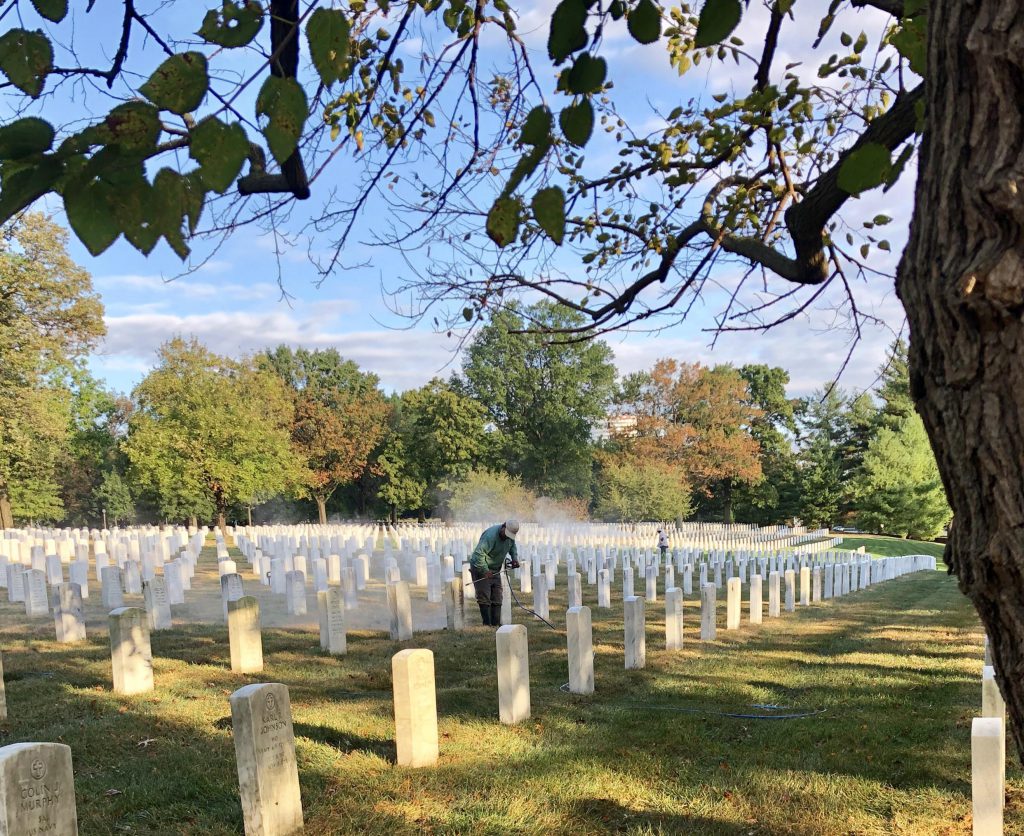Preparing Cemetery Monuments to Clean
Many monuments consist of two or more stones that are placed on top of each other. These stones should have spacers between the layers to prevent water and ice damage. Soft metal spacers are placed about a quarter of an inch in from the edges at each corner. Old-timers recommend copper pennies when restoring headstones.
Broken white stones can be repaired using Portland White Cement. The broken surfaces should be thoroughly cleaned and wet when the cement is applied. The cement should be mixed with water to a heavy paste-like consistency. Apply the cement to the lower section of the stone and then place the upper section onto the lower. Brace the stone on the front and the back making sure everything is straight. Remove any excess cement with a putty knife. Gently wipe the repaired joint with a wet sponge to clean off cement from the surface and to smooth the joint. Don’t wash repaired stones until the cement has had plenty of time to harden.
Do not drive off of the access roads. Don’t let your hoses damage flowers. If there is a funeral, do not work until the ceremony is over. Do not let people sneak up on you!
Because of splash back, raingear is usually a good idea. Be sure to have permission from the proper authorities before you start cleaning headstones. Don’t spend too much time reading the stones.
When working with older stones, it’s common to have to straighten the markers. It is especially common in climates where the frost goes deeply into the ground and causes the stones to shift. A shovel and pry bars are the only tools needed for most smaller markers. First dig around the stone until you can get the pry bar underneath it. With the stone pried up, fill underneath with gravel. Continue around the stone until it is leveled, and then replace the dirt and sod. Bigger monuments can require cranes and jacks to straighten. Fortunately larger monuments usually have a more extensive foundation and don’t need straightening as often.
Mix a marble cleaning solution of 1 gallon of bleach, one half gallon of Limonene, and 3 1/2 gallons of water. Direct spray this solution on the stone. Allow dwelling time of 20 minutes, no less. Mist the surface with water just enough to prevent drying, if necessary. Pressure-wash the surface. Pay attention to the affect of the pressure on the stone. Never apply so much pressure that you cause surface damage. Most stones can be pressure washed quite hard without any damage, but some stones are softer and require a gentler touch. If the stone is soft and a shadow of the removed mildew remains, choose to leave the stain and not to damage the stone. The shadows of removed mildew lighten for a few days after washing the stone, so they get whiter with time.
An extra step that you can take for difficult stones is to apply a bleach mixture a few days after washing. The mixture should be one part bleach to four parts water direct sprayed onto the stone and left there. Do not wash it off. It will help fade any remaining stains. Cold water washing works well when washing stones.
On rough granite surfaces, lichen grows and it can be hard to totally remove evidence of where it was when you remove it. Soak the lichen with the chemical solution and don’t cut the dwell time short for easiest removal.
Remember to Power Through! But be delicate with cemetery markers.



